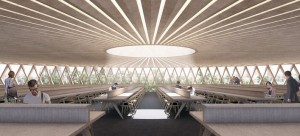The user experience is crucial in all kinds of commercial architecture. Whether it is an office, a theatre, a shop, or any other type of space, people want to have good experiences. One thing you need to look at to achieve this is sound. You have to align it with the goals for the space.
What do you need?
The problem here is it’s not always black and white. Some spaces want to dampen sound so it does not disturb people. This is the case with open plan offices. However, others spaces want to direct the sound effectively to the audience. A lecture theatre is a great example.
So, what do you do to get the best user experience? The key is to focus on the use and intention of the space. You can then take steps to get the right design.
Sound dampening
 If you want it so noises won’t reverberate through a space you should look at sound absorption. There are plenty of materials that can effectively absorb the sounds. For example, carpet is a really good option for floors. Textile panels are great for walls. The fabrics can help to make spaces much quieter because they absorb soundwaves rather than simply bouncing them back. You get that with concrete, glass, and other dense materials.
If you want it so noises won’t reverberate through a space you should look at sound absorption. There are plenty of materials that can effectively absorb the sounds. For example, carpet is a really good option for floors. Textile panels are great for walls. The fabrics can help to make spaces much quieter because they absorb soundwaves rather than simply bouncing them back. You get that with concrete, glass, and other dense materials.
An interesting option is to look at wood. Generally it is highly reflective and noises will bounce off. However, you can easily adapt it to provide dampening instead. Simply creating perforations or ensuring the surface isn’t completely flat and smooth can help.
If you have an open plan office where you don’t want phone calls or meetings to disturb people who are trying to work quietly, dampening can be a fantastic option. It can ensure people have a better experience so they don’t have to deal with noise. It can really elevate the commercial architecture.
Sound reflection
As we said above, some spaces don’t want to dampen sound at all. Instead, they want to direct it effectively to amplify it for users. This is a good strategy for theatres, lecture halls, and other spaces. The reflection can ensure that sounds travel effectively to the audience. It can mean they have a better experience where they can easily hear the lecturer or performance.
Here the goal will be to design the space meticulously to direct the sound where you want it. This can make sure it travels to the audience without distortion or a loss of volume. You can use different types of reflective panel on walls and the ceiling to achieve it.
Sound diffusion
One of the most sophisticated things you can do is use diffusion. It is the best way to achieve acoustic balance. What you do is make it so the sound will disperse evenly. In addition, it can minimise echoes and optimise sound quality.
You can utilise sound diffusion by choosing panels for the walls and ceilings. They scatter the sound to ensure there is no unwanted echo or resonance. This kind of strategy is especially good for spaces for audio recording.
Let us help you create commercial architecture with a great user experience
Coffey Architects can help clients to be successful with their properties. We can focus on achieving a great user experience for any kind of space. This could be a massive open plan office, a library, art gallery, or anything else. We can look at sound and the acoustics as part of this. If you do need dampening, reflection, or diffusion, we can consider materials and products that will do it while also offering aesthetic benefits.
So, speak to us today about commercial architecture. We’d be happy to work with you.